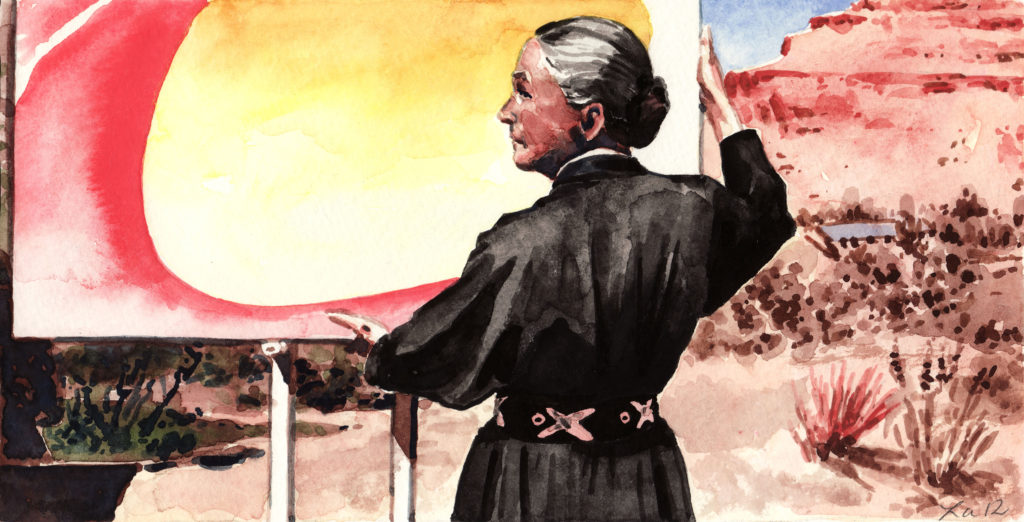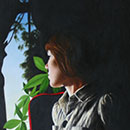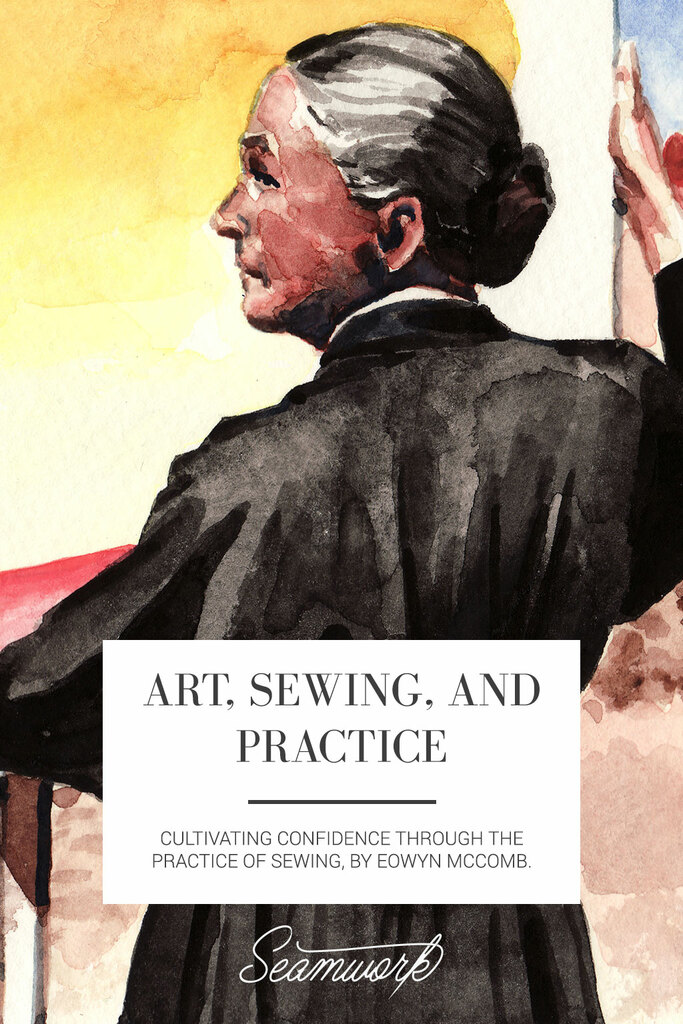“Perhaps, for something to be found, the only thing that matters is that there be searching.”
–Jane Hirschfield
Ever since getting diagnosed with social anxiety before I entered art school as a teenager, I have searched for a way to be and to share myself that doesn’t depend on my halting and stumbling inability to talk and think in group situations. Being around other people, especially strangers, is deeply unsettling, and generally very frightening. But although my work as an artist is done in the solitude of a studio, I still have to be in the world, to meet other people and face their judgment. This fills me with fear. How can I communicate when my feeling for words deserts me? Will other people think less of my artwork if I make a poor impression as a person?
This problem was on my mind as I read a book of theory that included a section on fashion. As I read, it struck me that clothing was a symbolic language, a non-verbal and visual way to communicate with others. Perhaps clothing could be a way that I could extend the interests in my art to the way I look and move in the world; maybe it could even be a way to bridge some of my social fears.
I read Walter Benjamin’s statement that in fashion, “Form and content, veil and veiled are the same.” And further on, Roland Barthes stated that “fashion . . . constitutes a technique of opening the invisible.” I interpreted this to mean that clothing can be one way of making visible the invisible world of the inner self: the feelings, dreams, and desires that no one else can see without our intentional act of sharing them.
Reading on, I wondered whether clothing is a costume, an illusion, a mere projection, or a reflection of our true selves: inner wishes shown on the outer body in the form of cloth and metal and beads? Even if our clothing is a shadow-self told in an ambiguous language, it always reflects something important: what we wear imitates who we want to be, or who we want to fit in with. Clothing can be used to define our differences and distinctions, like the white dresses of the poet Emily Dickinson, the intricate traditional Mexican clothing of the painter Frida Kahlo, or the painter Georgia O’Keefe dressed austerely in black against the backdrop of the colorful desert.
Our clothing can be used to signal allegiance with a group, like the abstract-expressionist painters Joan Mitchell and Elaine DeKooning, who wore rumpled trousers and paint-splattered button-up shirts to show their identification with the mostly-male New York club of carousing, hard-working painters—their adoption of masculine clothing during the extremely feminine 1950s was another proof they could be “one of the boys.”
But how could I translate my desire to communicate something about myself and my artwork through my clothing when I had so little money to spend on clothes? I felt limited in choice by my limited means. This led me back to sewing, which offered me almost unlimited aesthetic choices on a very small budget.
As I began to practice sewing more regularly, I wondered if it was a good use of my time, or whether I was misplacing my energies. It took so long to make a garment, yet they were so readily and cheaply available on the clearance rack and at the thrift store. Was my wish for more personal clothing wasteful?

During this period of alternating work, learning, and self-doubt, I came across a copy of Full Bloom, a biography of painter Georgia O’Keefe by Hunter Drehojowska-Philip, and was surprised and validated to learn that O’Keefe was both an undeniably powerful painter and an adept seamstress who made most of her own clothes throughout her life, and continued to sew for pleasure even after she could afford hand-tailored clothing from the best designers. O’Keefe’s clothing closely followed the aesthetic paradoxes of her artwork: It was both severe and sensual, spiritual and down to earth, simple and luxurious, feminine and masculine. She wore pantsuits with the same confidence that she wore long, elegant dresses. She showed the same care choosing her clothes and jewelry that she used in composing her paintings.
Here was an example I could admire—a woman who attempted unity in artwork and in life, who made and wore clothing that reflected her hard-won personal aesthetic, and on a deeper level, her sense of self. The simplicity of the black and white that she wore all her life framed the brilliant range of color in her paintings. That preference for black clothing made her misunderstood, especially in her youth when it was considered socially inappropriate to wear black except during the period of mourning. But the severity and plainness of black suited her and she chose to wear it anyway, focusing all her color into her art.
“The painting is like a thread that runs through all the reasons for the other things that make one’s life,” Georgia O’Keefe said, conjoining painting and needlework in one metaphor, proving poet Jane Hirschfield’s theory that “for the artist, everything interests, instructs, is put to use,” including sewing.
Clothing is essentially about selfhood. It is about who we are, and how we choose to share that with other people. But creating, fashioning, defining oneself is not an overnight process. Georgia O’Keefe’s example shows that to develop one’s own tastes, to come to self-knowledge, is a life-long journey. While she always showed a preference for black, her clothes grew more stark, simple, and stylized over the years, and drew from increasingly wide-ranging ethnic sources of inspiration. Our clothes are bound to change along the path of our lives, embodying different dreams, covering different fears, addressing different needs as they arise.
Reflecting on my present situation, I have to admit that I don’t know where my artwork will take me next, or how to best embody my values in my clothing, despite working on this problem for several years now. There is a great deal of uncertainty and fear to face in the studio and in front of the sewing machine. Confidence does not come easily.
So what can I do? I can practice. Practice dressing myself, practice sewing, just like the other forms of work that I practice on a daily and weekly basis. “Everything depends on how we practice,” writes musician Glenn Kurtz in his book Practicing. “Everything depends on . . . what we practice.” This is because our daily practice, over time, becomes who we are.
In my religion there is a beautiful and oft-quoted scripture that teaches that “by small and simple things are great things brought to pass.” Our decisions, even ones as small and simple as what to wear each morning, affect how we feel about ourselves. They embody our goals of who we want to be, reflect our values, and communicate our intentions to others. Whenever I make the decision to sit down in front of my sewing machine, I have a quote by the writer-gardener Gertrude Jekyll that I try to ask myself with every project: “Is it worth having? Is it worth doing?” And I could add to it: “Will it help me learn something new? Will it teach me something about myself?”
Glenn Kurtz also writes that practicing is “a process of continual reevaluation, an attempt to bring growth to repetition.” I consider that a very accurate description of sewing: a process where we pause each time we plan or finish a garment to reevaluate our self-image, a continuum of work that is repetitive, but hopefully ultimately satisfying because of the growth that results—growth of skill, of confidence, of self-understanding. Practice is ennobling because it brings growth. Incremental, perhaps, discouragingly slow, perhaps, but ultimately you cannot help but grow if you work steadily and practice with patience. As Kurtz writes, “Practice gives direction to your longing, gives substance to your labor. . . Practicing is the truth of who you are, today, as you strive to change, to make yourself better. . .”


